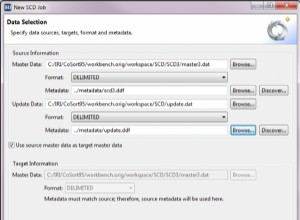Tentu, itu mungkin dengan cara yang sangat mudah jika skemanya sama. Dan karena Anda membuat kedua database dengan pemetaan Hibernate yang sama, keduanya harus sama di Entity akal.
Anda hanya memerlukan dua unit persistensi Hibernate (sumber data). Jika keduanya dikonfigurasi dengan benar dan Anda memiliki EntityManager tertentu contoh praktis, cukup buka Session Hibernate level - sejauh yang saya tahu JPA tidak mendukungnya dengan cara ini (koreksi saya jika saya salah) - dan replikasi entitas sumber Anda ke database target Anda.
Karena saya suka bekerja dengan Spring, saya akan menggunakan Spring Boot untuk contoh berikut. Kecuali konfigurasi, langkah replikasi akan diterapkan sama dengan aplikasi Hibernate apa pun.
Saya juga menggunakan dua database PostgreSQL alih-alih HSQLB hanya untuk membuatnya tetap sederhana. Perluas saja bagian konfigurasi jika konfigurasi Anda terpisah, satu-satunya perbedaan antara unit persistensi saya adalah url sumber data.
Jadi pertama-tama kita membutuhkan entitas untuk menguji replikasi:
import javax.persistence.Entity;
import javax.persistence.GeneratedValue;
import javax.persistence.Id;
@Entity
public class StorageEntry {
@Id
@GeneratedValue
private Long id;
private String someValue;
// imagine getters and setter here
}
Ini (versi YAML dari) konfigurasi dua sumber data (lihat url sumber data kedua yang disebut targetDatabaseUrl ), Semua bagian lain dari konfigurasi akan digunakan untuk kedua unit persistensi:
spring:
datasource:
url: jdbc:postgresql://localhost/postgres
targetDatabaseUrl: jdbc:postgresql://localhost/postgres2
username: <username>
password: <password>
driver-class-name: org.postgresql.Driver
jpa:
database-platform: org.hibernate.dialect.PostgreSQLDialect
hibernate:
ddl-auto: create-drop
Bagian selanjutnya adalah kelas konfigurasi untuk sumber data:
import java.util.Properties;
import javax.persistence.EntityManager;
import javax.persistence.EntityManagerFactory;
import org.springframework.beans.factory.annotation.Autowired;
import org.springframework.beans.factory.annotation.Value;
import org.springframework.context.annotation.Bean;
import org.springframework.context.annotation.Configuration;
import org.springframework.jdbc.datasource.DriverManagerDataSource;
import org.springframework.orm.jpa.JpaTransactionManager;
import org.springframework.orm.jpa.JpaVendorAdapter;
import org.springframework.orm.jpa.LocalContainerEntityManagerFactoryBean;
import org.springframework.transaction.PlatformTransactionManager;
@Configuration
public class PersistenceConfig {
@Autowired
private JpaVendorAdapter jpaVendorAdapter;
@Value("${spring.datasource.url}")
private String databaseUrl;
@Value("${spring.datasource.targetDatabaseUrl}")
private String targetDatabaseUrl;
@Value("${spring.datasource.username}")
private String username;
@Value("${spring.datasource.password}")
private String password;
@Value("${spring.datasource.driver-class-name}")
private String driverClassName;
@Value("${spring.jpa.database-platform}")
private String dialect;
@Value("${spring.jpa.hibernate.ddl-auto}")
private String ddlAuto;
@Bean
public EntityManager sourceEntityManager() {
return sourceEntityManagerFactory().createEntityManager();
}
@Bean
public EntityManager targetEntityManager() {
return targetEntityManagerFactory().createEntityManager();
}
@Bean
public EntityManagerFactory sourceEntityManagerFactory() {
return createEntityManagerFactory("source", databaseUrl);
}
@Bean
public EntityManagerFactory targetEntityManagerFactory() {
return createEntityManagerFactory("target", targetDatabaseUrl);
}
@Bean
public PlatformTransactionManager sourceTransactionManager() {
return new JpaTransactionManager(sourceEntityManagerFactory());
}
@Bean
public PlatformTransactionManager targetTransactionManager() {
return new JpaTransactionManager(targetEntityManagerFactory());
}
private EntityManagerFactory createEntityManagerFactory(final String persistenceUnitName,
final String databaseUrl) {
final LocalContainerEntityManagerFactoryBean entityManagerFactory = new LocalContainerEntityManagerFactoryBean();
final DriverManagerDataSource dataSource = new DriverManagerDataSource(databaseUrl, username, password);
dataSource.setDriverClassName(driverClassName);
entityManagerFactory.setDataSource(dataSource);
entityManagerFactory.setJpaVendorAdapter(jpaVendorAdapter);
entityManagerFactory.setPackagesToScan("com.example.model");
entityManagerFactory.setPersistenceUnitName(persistenceUnitName);
final Properties properties = new Properties();
properties.setProperty("hibernate.dialect", dialect);
properties.setProperty("hibernate.hbm2ddl.auto", ddlAuto);
entityManagerFactory.setJpaProperties(properties);
entityManagerFactory.afterPropertiesSet();
return entityManagerFactory.getObject();
}
}
Sekarang Anda dapat menggunakan pengelola entitas yang berbeda untuk sekadar membaca dan menulis data Anda dari satu sumber data ke sumber data lainnya. Untuk menunjukkan bahwa ini adalah kasus uji kecil:
import static org.hamcrest.CoreMatchers.notNullValue;
import static org.hamcrest.CoreMatchers.nullValue;
import static org.hamcrest.MatcherAssert.assertThat;
import javax.persistence.EntityManager;
import javax.persistence.PersistenceContext;
import org.hibernate.ReplicationMode;
import org.hibernate.Session;
import org.junit.Test;
import org.junit.runner.RunWith;
import org.springframework.boot.test.context.SpringBootTest;
import org.springframework.test.context.junit4.SpringRunner;
import org.springframework.transaction.annotation.Transactional;
import com.example.model.StorageEntry;
@SpringBootTest
@RunWith(SpringRunner.class)
@Transactional(transactionManager = "targetTransactionManager")
public class ReplicationTests {
@PersistenceContext(unitName = "source")
private EntityManager sourceEntityManager;
@PersistenceContext(unitName = "target")
private EntityManager targetEntityManager;
@Test
public void copyEntityBetweenPersistenceUnits() {
final StorageEntry entityToCopy = new StorageEntry();
entityToCopy.setSomeValue("copyMe!");
sourceEntityManager.persist(entityToCopy);
final Long id = entityToCopy.getId();
final StorageEntry sourceEntity = sourceEntityManager.find(StorageEntry.class, id);
assertThat("Entity should exist in default schema!", sourceEntity, notNullValue());
StorageEntry targetEntity = targetEntityManager.find(StorageEntry.class, id);
assertThat("Target schema should not contain the entity, yet!", targetEntity, nullValue());
final Session hibernateSession = targetEntityManager.unwrap(Session.class);
hibernateSession.replicate(sourceEntity, ReplicationMode.OVERWRITE);
targetEntityManager.flush();
targetEntityManager.clear();
targetEntity = targetEntityManager.find(StorageEntry.class, id);
assertThat("Entity should be copied now!", targetEntity, notNullValue());
}
}
Terakhir, pilih salah satu kemungkinan mode replikasi yang sesuai dengan kebutuhan Anda.
Itu saja. Anda bahkan dapat menggunakan transaksi, cukup tentukan salah satu unit persistensi dan manfaatkan pengelola transaksinya seperti yang dilakukan pengujian dengan @Transactional(transactionManager = "targetTransactionManager") .




